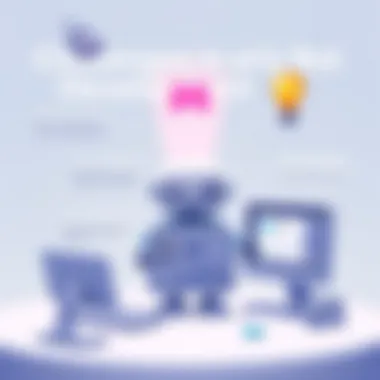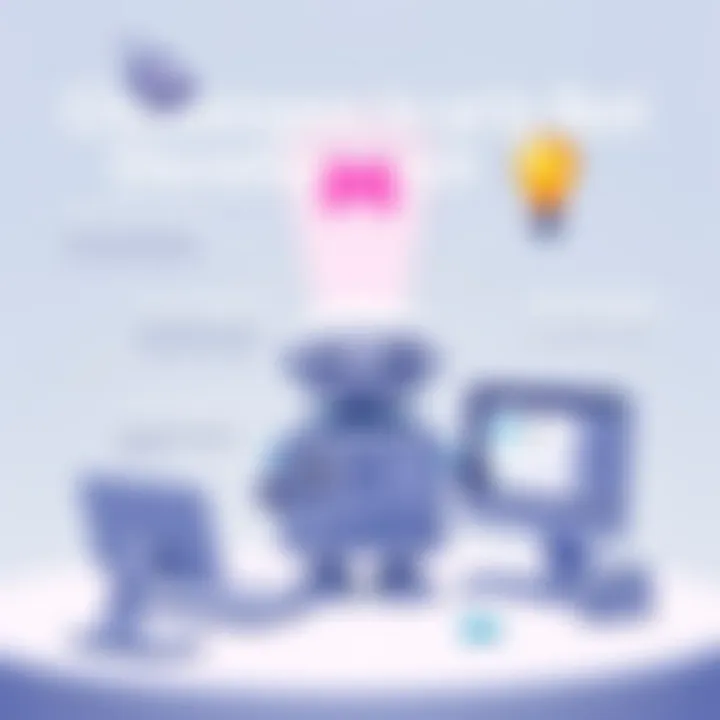The Growth of Bot Development on Discord


Intro
The Discord platform has become a cornerstone for online communities, facilitating connections among users worldwide. But this vibrant ecosystem would not be what it is today without the innovation of bots early on. In the beginning, developers faced not just technical hurdles but the challenge of figuring out how to make bots that could understand and enhance user interaction.
At its inception, Discord opened its doors in 2015, later allowing developers to create bots via its API. The initial exploration of bot creation revolved around simple functionalities like moderation, utility commands, and music playback. Such features laid the groundwork for more sophisticated tools that we see today.
Bots have evolved from being mere novelty items to integral components of the platform, engaging users in ways previously thought impossible. The following sections will delve into the key features of these early bots, the technology they were built upon, and the challenges faced by those early developers.
Through examining this evolution, we can appreciate not just where we are now but also glimpse into the future of bot development on Discord.
Intro to Discord and Its Ecosystem
In recent years, the significance of Discord as a communication platform has grown dramatically, shaping how communities connect and interact online. For many users, Discord isn’t just a tool for chatting; it serves as a digital hub for friends, gaming groups, and even professional networks. The platform provides a seamless user experience that encourages both casual and in-depth discussions, helping foster connections among individuals who share similar interests.
Discord allows users to create servers with unique themes and purposes. Each server is a microcosm, complete with channels for different topics, facilitating organized communication rather than chaotic exchanges typically seen on other platforms. With text channels, voice chat, and even video options, it caters to all forms of interaction. The platform's flexible architecture adapts well to a variety of groups, from gaming clans to study groups, effectively solidifying its place in the digital communication ecosystem.
Overview of Discord as a Communication Platform
Discord emerged from a background typically dominated by gamers but has quickly expanded beyond that niche. What began as a platform for voice chat during gaming sessions has evolved into a multifaceted communication vehicle. The platform's design emphasizes ease of use and accessibility, making it a popular choice across various demographics.
In addition to traditional chat functionalities, Discord supports integrations with various applications, giving users the freedom to customize their experience. Bots, for instance, enhance functionality by offering administrative support, entertainment, and even automated responses—all tailored to user needs. This customizable approach to communication appeals to tech-savvy individuals, gadget lovers, and early adopters of technology alike.
The Role of Bots in Enhancing User Interaction
The introduction of bots into the Discord ecosystem marked a turning point for user engagement. Bots serve multiple roles, such as moderation assistants, interactive game facilitators, or even music players. They augment human interaction, providing a continuous experience that keeps users engaged.
Bots have transformed the way users interact on servers:
- Moderation: Bots can efficiently manage multiple tasks simultaneously. They can kick or ban users for rule violations and keep the environment welcoming and organized.
- Games and Quizzes: Community engagement often takes form in fun events like trivia and games facilitated by bots. This interactivity keeps users returning for more.
- Information Retrieval: Users can summon bots for information, pulling data from other sources instantly. This type of integration with APIs presents a time-saving option for discussions that require quick answers.
"Bots are like the Swiss Army knives of Discord; they serve many purposes and can adapt to the needs of the community."
As more developers delved into creating unique bots, the possibilities became endless. Bots have reshaped interactions, allowing Discord to evolve into a platform rich in content and community. This evolution continues to pave the way for enhanced user experience, ensuring that Discord remains at the forefront of communication technology.
The Genesis of Bot Development
The dawn of bot development on Discord was not just a technical shift; it represented a cultural evolution within online communities. Before we dive deeper into this topic, understanding the significance of bots is crucial. These digital assistants have shaped user interaction, making communication more efficient and engaging.
Early bot developers encountered numerous hurdles, yet their innovation carved the path for future functionalities. By exploring the origins of these developments, we grasp the nuances that have led to today’s sophisticated bots. The aspects examined here emphasize the importance of creativity, technical prowess, and a user-centered mindset. Throughout this section, key concepts will surface, highlighting how initial experiments were not futile endeavors, but rather building blocks for a much larger structure of interactivity that we enjoy today.
Early Concepts and Theories in Bot Functionality
The initial ideas surrounding bot functionalities seemed almost rudimentary, yet they laid the groundwork for advanced interactive experiences that we often take for granted. In those early days, developers pondered basic capabilities: would bots merely respond to commands, or could they learn from interactions? This fundamental question guided early design choices, shaping the trajectory of bot development.
Consider the simplicity of a bot that primarily served reminders. It wasn’t about complex algorithms or artificial intelligence; it was more about punctuality in user interactions—a reminder to participate in events or to follow up on discussions. This concept unveiled a broader understanding of what bots could signify: an enhancement of users’ lives without much fuss.
Moreover, early theorists debated about the emotional ties between users and bots. Could a bot develop a personality? Initial attempts to imbue bots with simple conversational abilities were met with curiosity. Every command they recognized was a step towards creating a semblance of companionship in a digital world—a notion that still resonates in current bot design methodologies.
Initial API Releases and Their Features
The role of APIs cannot be overstated when discussing the inception of bot development for Discord. The initial releases of the Discord API were akin to giving a child a box of crayons; the potential creativity was boundless. Early features, although basic in comparison to today’s standards, offered essential building blocks.


For instance, the ability to listen to messages and respond constituted a significant feature of the API. This foundational action opened doors not only for command-driven tasks but also for a more natural flow of interaction between users and bots. Developers eagerly experimented with features like user authentication, role assignments and event logging, each serving specific community needs while simultaneously pushing the envelope on functionality.
"The capabilities set forth by the early API releases acted like a spark—igniting creativity and innovation in bot development that was previously just a flicker of potential."
Through this initial journey of bot development, we observe that early developers were not merely creators of software but pioneers navigating uncharted territory. Their experiences solidified the groundwork for what would evolve into an ecosystem teeming with sophisticated bot interactions today. From early theories of engagement to the exciting release of APIs, every step contributed uniquely to the rich narrative of Discord bot development.
Technical Foundations for Building Discord Bots
Understanding the technical foundations that underpin Discord bot development is crucial for anyone looking to traverse this dynamic landscape. These foundations not only include the programming languages used but also delve into the mechanics of how bots interact with Discord's infrastructure through APIs and webhooks. Mastering these elements can empower developers to create sophisticated bots that elevate user experience and streamline community engagement.
Programming Languages Commonly Used in Bot Development
When it comes to developing bots for Discord, a variety of programming languages can come into play, each with distinct strengths and weaknesses. JavaScript, Python, and Java are often the front-runners.
- JavaScript: This is perhaps the most ubiquitous language in the web development world, making it the go-to for many Discord bots due to its versatility and integration with Node.js. The asynchronous nature of JavaScript pairs nicely with real-time communication, which is a cornerstone of how Discord operates.
- Python: Known for its readability and simplicity, Python has gained traction among bot developers. With libraries like discord.py, the ease of tapping into Discord's functionalities makes Python a favorite among those who prefer a less verbose coding style.
- Java: While it may be less common than the first two, Java’s robustness and scalability can’t be overlooked. Its strong type system and object-oriented nature make it a suitable choice for complicated bot functionalities.
As each language carries its charm, choosing one often depends on the developer’s familiarity and the specific project requirements.
Understanding Discord API and Webhooks
The Discord API serves as the linchpin of bot functionality. It provides an interface for developers to interact with Discord's core features, including sending messages, managing servers, and performing user authentication. Through the API, bots can operate in real-time, reacting to events such as new messages or member joins.
A well-designed bot harnessing the power of the Discord API can enrich interactions beyond typical text exchanges.
Webhooks, on the other hand, are a simpler way to send messages from outside Discord to a channel. They provide a simplified option for developers who wish to integrate external services without delving as deep into bot programming. Considered a lightweight alternative, webhooks are excellent for tasks such as posting alerts, notifications, or updates. The distinction between using the API and webhooks often comes down to complexity and the particular use case.
Frameworks and Libraries That Paved the Way
Several frameworks and libraries have streamlined the bot development process and contributed to significant growth in the ecosystem. Notably, Discord.js and discord.py have set the standard for JavaScript and Python developers, respectively.
- Discord.js: This powerful library simplifies the use of the Discord API for JavaScript developers. Its documentation is extensive, providing newcomers with the resources needed to get started quickly. The asynchronous nature of the library allows bots to handle multiple tasks simultaneously without significant overhead.
- discord.py: Much like its JavaScript counterpart, discord.py is designed to allow Python developers to effortlessly interface with the Discord API. Its elegance and clarity make it favored by many in the bot development community, opening doors for user-friendly bots with rich functionalities.
By leveraging these libraries, developers can focus more on building unique features for their bots rather than getting bogged down in the nitty-gritty of API calls.
In summation, the technical foundations for building Discord bots encompass a variety of programming languages, a deep understanding of API functions and webhooks, and the utilization of powerful frameworks. Each element plays a pivotal role in shaping the capabilities and effectiveness of the bots that ultimately enrich the Discord experience. With these tools in hand, aspiring developers are equipped to embark on their bot-building journeys.
Challenges Faced by Early Bot Developers
In the vibrant landscape of Discord, even the most ambitious bot developers were met with a slew of hurdles. These challenges weren't just minor speed bumps; they were critical elements that influenced both the trajectory and capabilities of bot development. Understanding these obstacles shines a light on the transformative journey from basic functionalities to the advanced features we see today. The early developer's struggles laid the groundwork for the resilient, sophisticated bots serving communities now.
Technical Limitations and Scalability Issues
The technical limitations faced by pioneering bot developers were manifold. Many early bots operated on a limited framework, often constructed using basic programming languages or outdated libraries. This restricted their ability to interact seamlessly with Discord’s expanding capabilities. The scaling issue was particularly pronounced. Early bots could handle only a small number of simultaneous users, which rendered them ineffective in large servers, where user engagement peaked.
"Developers encountered a stark reality: their creations, while innovative, were often handicapped by their own architecture."
Early bot creators often found themselves at the mercy of Discord's API, which was still evolving and frequently subject to changes. Documentation was sometimes sparse or unclear, presenting an additional layer of complexity. As they attempted to code more complex functions, they often stumbled into walls where the API simply couldn’t support them, leading to frustration and disillusionment.
Moreover, the absence of reliable libraries made it challenging to introduce scalable solutions. Developers scrambled to modify their code so it could handle growth, often leading to an unwieldy mess of patches and hacks instead of a well-structured and efficient bot. This juggling act of maintaining performance while trying to enhance features turned into a tightrope walk that even seasoned developers found daunting.
User Privacy and Data Security Concerns


As with any technology interfacing with users, privacy and security emerged as paramount concerns for early bot developers. At a time when users were starting to realize the importance of protecting their personal data, the bots collecting user information often lacked the robust security protocols to safeguard that data.
Many developers didn’t initially grasp the significance of privacy policies and data encryption, leading to potential vulnerabilities. Bots often required permissions that, at face value, seemed harmless but could lead to unintended data exposure. Users, understandably wary, began questioning what data was being collected and how it was being utilized. The onus fell on developers to build trust through transparency.
Additionally, as bots began to incorporate more features, the potential for exploiting user data opened a Pandora's box of ethical considerations. Not every developer adhered to best practices for handling sensitive information, leading to cases of data leaks or misuse, which subsequently sparked scrutiny from both users and regulatory bodies.
These privacy concerns instigated a much-needed dialogue about ethical data usage in bot development. Developers had to pivot their strategies, placing a greater emphasis on user consent and protection. This shift marked a significant step forward, demonstrating that amidst the challenges, developers were learning and adapting, ultimately fostering a safer environment for users in the Discord ecosystem.
In summary, navigating the challenges of technical limitations and user security became not just a hurdle but a catalyst for growth and evolution within the community. As Discord bots progressed from simple programs to complex interactive entities, the lessons drawn from these challenges continue to inform best practices today.
The Impact of Bots on Community Engagement
Bots have become a cornerstone of interactions on the Discord platform, influencing how communities operate, engage, and grow. Their effectiveness in boosting user interaction across various channels cannot be overstated. They serve multiple functions, from automating mundane tasks to creating an enticing environment where users feel more connected. This section looks into how bots have transformed community engagement and why they are crucial for fostering vibrant online spaces.
Bots as Moderators and Their Evolving Responsibilities
In the early days of Discord, the need for moderation was evident. Bots stepped into this role, handling tasks like filtering spam, enforcing rules, and monitoring chat behavior. As the chat rooms began to swell with users, moderators often found themselves overwhelmed with the influx of discussions and debates. Bots helped alleviate some of this pressure by providing essential support, enabling a seamless experience for users.
Over the years, the responsibilities of these moderator bots have expanded. Advanced moderation bots, like MEE6 and Dyno, have integrated features that allow for customized responses based on user queries, interaction logging, and automated warning systems. These improvements not only help enforce community rules but also fine-tune them according to user feedback, thus ensuring that moderation is both effective and adaptive.
The evolution of command structures has enabled these bots to respond to users on an individual level. They’re no longer just tools for blocking undesirable behaviors; they’ve become integral in shaping a positive user experience. This shift shows a clear trajectory toward building more sophisticated community guidelines that consider all members’ needs.
"The role of bots has shifted from mere gatekeepers to vital participants in community culture, enhancing engagement rather than policing it."
Fan Engagement Through Interactive Bots
Interactive bots have emerged as a powerful tool for community engagement. They are no longer limited to functions that simply relay information; instead, they now facilitate real-time interactions that keep users coming back for more. Imagine being able to play games like Trivia with your friends or participating in polls on favorite topics directly within the chat—these experiences are made possible by bots.
These bots can perform a range of actions, including:
- Creating polls that help gauge community sentiment.
- Running quizzes that encourage friendly competition.
- Hosting game nights where members can join and play together.
Consider a music bot that allows users to queue songs or share playlists. This engagement leads to enhanced user experience and fosters connections within the community. This is especially critical for niche communities where shared interests often form the backbone of user interaction.
As these interactive functions expand, the potential for building deeper connections continues to grow. Developers will need to remain attuned to ever-changing trends in user preferences, ensuring bots evolve alongside community dynamics.
In essence, bots are not just autonomous tools; they serve as critical liaisons that enhance user experience. Their ability to adapt to user needs and preferences creates a more dynamic community, encouraging participation and retention. The ongoing innovation in bot development foreshadows a future where engagement strategies will be even more intricate and personalized.
Innovations and Trends in Bot Development
The landscape of Discord bot development has evolved significantly, influenced by a host of innovations and trends. Understanding these factors not only clarifies the current capabilities of bots but also sheds light on how they're shaping the future. In this section, we'll delve into the key elements driving changes in bot design and discuss their broader implications on user experience and engagement.
The Rise of AI and Machine Learning in Bot Design
The integration of AI and machine learning technologies into bot development represents a seismic shift in how bots operate. Unlike the early bots that often executed predefined commands and followed basic logic, modern bots are harnessing machine learning algorithms to process information and engage users in a more natural way. This allows them to learn from interactions, adapt their responses, and even anticipate user needs. For instance, if a bot has a user who frequently asks about gaming news, it can start to push notifications about relevant updates without waiting for the user's request.
There are several notable advantages to using AI in bot design:
- Enhanced User Experience: Bots can provide personalized experiences, tailoring responses based on past interactions.
- Increased Efficiency: Smart bots can handle user inquiries faster and more accurately, reducing wait times and improving satisfaction.
- Scalability: They can manage a high volume of interactions simultaneously, making them ideal for growing communities.
- Continuous Improvement: Through data analysis, these bots can evolve their features over time, implementing changes based on user feedback or emerging trends.
However, moving towards AI presents challenges, particularly regarding complexity and transparency. Developers must ensure that AI-driven bots are easy to understand and interact with, to prevent users from feeling alienated by the technology that supports them.


Trends Influencing Future Bot Capabilities
The role of bots within Discord is continuously being shaped by emerging trends that influence their development and usage. As new developments arise in the tech landscape, they invariably impact bot features and functions. Here are some prominent trends:
- Natural Language Processing (NLP): As bots become better at understanding human language nuances, they're able to hold more fluid conversations. Users expect bots to understand phrases and context, leading to more sophisticated designs.
- Integration with Other Platforms: Bots that can pull information or interact across different platforms, like Twitch or Twitter, are becoming increasingly popular. This functionality fosters a seamless experience for users who engage across multiple networks.
- Community-Driven Development: Many developers are now relying on community input to shape their bot’s features. By soliciting feedback through Discord channels or forums, developers can tailor bots to better meet user desires and adapt quickly to changing interests.
- Privacy and Ethical Considerations: As concerns about data security rise, ensuring that bots handle user data responsibly is pivotal. Developers are now focusing on transparent data practices to build trust with users.
In sum, the innovations and trends we discuss here not just enhance bot capabilities; they also enrich the overall user experience within the Discord community. As platforms evolve, so too will the bots that inhabit them, ensuring a dynamic and engaging environment for users worldwide.
"In the world of tech, stagnation is the enemy of growth; the adaptability of bots illustrates that truth perfectly."
For further reading on the implications of AI on user interaction, visit Wired, an invaluable resource for insights into technology trends.
Future Perspectives on Discord Bot Development
The conversation surrounding the future of Discord bot development is pivotal, not only for developers but also for users. As the platform grows, the need for dynamic and responsive bots becomes increasingly vital. Understanding the potential directions for bot functionality allows developers to harness upcoming trends, optimizing user engagement while addressing community needs.
Potential Directions for Bot Functionality
Several exciting pathways are emerging on the horizon for how bots will evolve on Discord. First and foremost, integration with Artificial Intelligence is likely to take center stage. The ability to process natural language will allow bots to become more intuitive, driving meaningful conversations rather than simple keyword responses. As developers harness AI capabilities, expect bots to analyze context, learn from user interactions, and provide personalized experiences.
Here are some directions to consider:
- Enhanced Customization: Users will demand bots that they can tailor more closely to their communities. This could mean anything from adjusting behavior settings to selecting specific reactions during interactions.
- Gamification Elements: With the rise of interactive gaming communities on Discord, we may see bots incorporating more game-like aspects such as quests, rewards, and points systems to engage users deeply.
- Advanced Streaming Capabilities: Integrating bots with real-time streaming elements could enhance live interactions within channels, making discussions more vibrant and enabling functionalities like live polls or Q&A sessions.
- Cross-Platform Interoperability: With Discord's surge in popularity, there is increasing demand for bots that can bridge functionalities with other platforms, such as Twitch or Twitter. This can streamline user experiences, offering them unified interaction channels.
In essence, these developments could redefine user interactions and the overall experience within Discord communities.
Continued Evolution of User Interaction on Discord
As bot technology matures, so does the way users engage with it. The interaction that users have with bots will shape future developments. Ultimately, the end goal is a seamless blend of machine assistance and human interaction that feels natural.
More Human-Like Engagement: Users will expect more than automated messages. The rise of empathetic bots, responding not just with facts but with understanding and personality, could significantly enhance engagement.
- Contextual Awareness: Bots may start detecting user moods or preferences through sentiment analysis, leading to responses that feel less mechanical.
- Building Community Bonds: Bots will likely evolve from mere functional tools to community members themselves, hosting activities, participating in discussions, and contributing to the social fabric of groups.
Engaging bots that form a part of the user’s social experience, rather than existing solely as abstract entities, represent the future of Discord interactions.
"The true potential of Discord bots lies in their ability to not just facilitate actions, but to foster connections among users."
In summary, envisioning what lies ahead for Discord bot development highlights the balance needed between innovation and user-centric design. As developers navigate these advances, the alignment with community needs will dictate the trajectory of interactive experiences on Discord.
End
Summarizing the Journey of Bot Development
From rudimentary scripts that offered simple automated responses to the more complex systems imbued with machine learning capabilities, the journey of bot development on Discord has been remarkable. Initially, developers grappled with resource constraints and limited functionality, often depending on rudimentary programming languages such as Python and JavaScript. As the API evolved, it opened doors to a myriad of possibilities, pushing the envelope on what bots could do. Factors such as scalability, user interaction, and the ability to manage vast amounts of data have transformed bot functionalities over time.
"Early developers laid the groundwork, paving the way for increasingly sophisticated bots that define the Discord experience today."
With each innovation, the learning curve became steeper yet more rewarding. Developers embraced challenges as opportunities, leading to community-driven solutions that often spark further creativity. Each bot has indeed its story, encapsulating the skills, ideologies, and aspirations of its creator. This evolution marked by collaborative learning, serves as a reminder that the process is often just as valuable as the end product.
Reflections on the Community Impact
The impact of bots extends beyond mere functionality; they have dramatically influenced the culture and interaction within Discord communities. Bots have acted as moderators that foster a sense of security and order, allowing users to engage in discussions without the fear of toxicity or harassment. Additionally, they enhance user engagement by providing interactive features, from music-playing to trivia quizzes.
Bots enable more meaningful connections and create a sense of belonging within groups. This evolution has resulted in an environment where users feel more connected, both to the community and to each other. However, this doesn’t come without its discussions around privacy and data security. Balancing functionality against these concerns remains a critical consideration as development progresses.
The growth of bot technology showcases the collective strength of the Discord community. It also opens the gates for future innovations—hints of AI integration and deeper personalization of user experiences are just around the corner. It’s a future ripe with possibilities, compelling developers to innovate further and reimagine how bots can better serve their communities.
In sum, the journey of bot development isn’t just about advancing technology; it’s a story about community, creativity, and collaboration that continues to unfold.



